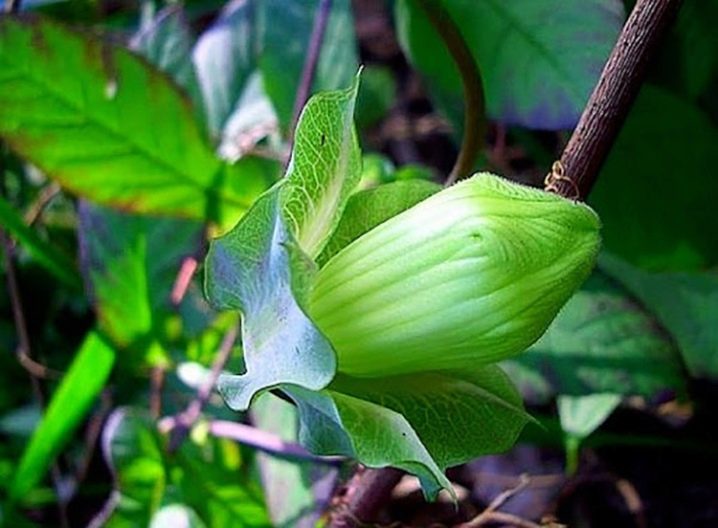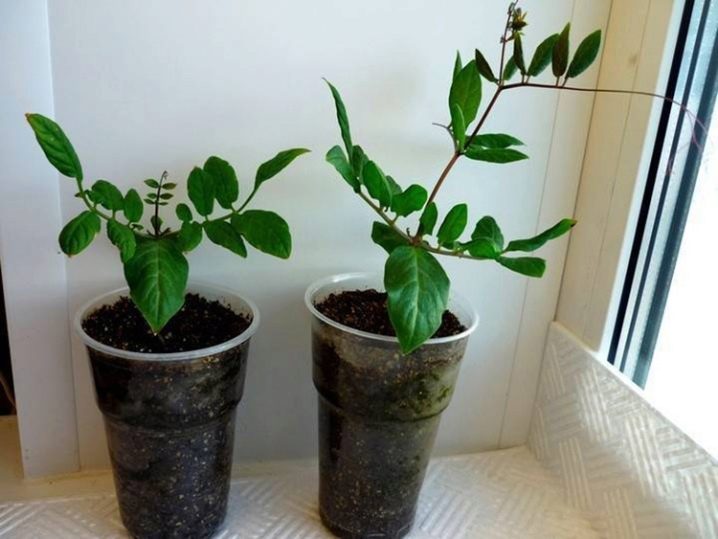Why isn't the kobei blooming and what to do about it?

Kobea is a beautiful tropical liana native to Mexico and South America. It is used for vertical gardening, filling arches and gazebos with wonderful greenery with flowers in the form of large bells. But it so happens that she does not bloom. In this case, many summer residents ask themselves why the kobei does not bloom and what to do. There are many reasons, let's try to figure them out.

Description
Kobei came to Europe in the 18th century. She amazed the Europeans with her splendor, but the climate turned out to be far from tropical, and growing a blooming liana in the new conditions became a difficult task. In Russia, out of 9 known species, only Cobaea scandens, a climbing cobea, is used. Domestic gardeners call it "monastery bells" for its spectacular large flowers (up to 8 cm), and for its ability to creep over supports - "Mexican ivy".
Kobei belongs to the Sinyushnikovye family... Liana Cobaea scandens grows up to 6 m long. The plant is perennial, but in the conditions of central Russia it cannot be left for the winter, so it has to be grown from seeds annually.
Over the summer, with proper care, the kobei manages to produce extensive green mass. Some gardeners remove the liana from the supports and with an earthy clod are transferred to greenhouse conditions, and in May they are again planted in the ground. But due to the difficulties with which the transplant is associated, few people resort to this method.

In a kobei, climbing leaves of a simple oval shape with clearly traced veins, are arranged in pairs on a long handle. Flowers rise on peduncles directly from the axils of the leaves. The color scheme is varied, you can see bells of white, yellow, pink, blue, purple shades.
The fruits look like a leathery capsule, but they rarely ripen in our climate. The plant has a strong root with a large number of branches, it reliably holds the liana overgrown with greenery.

Causes and solution of the problem
A tropical liana, adapted to our climate, can delight not only with greenery, but also with flowers. It is only necessary to take into account her preferences in the process of growing and caring. Mistakes are made by gardeners at all stages of vines development, and any of them can cause flowering to stop.
-
Seed material. If you use low-quality seeds, you can not only bloom, but also not wait for seedlings. You cannot use seeds of your own collection, in our climate they do not have time to ripen. You need to purchase planting material fresh, which is no more than a year old. Seed bags are easy to find in specialized stores.

-
Planting seeds in open ground. This is the second mistake. Kobeya is a thermophilic plant, it is planted in sun-warmed soil, when frosts are no longer worth fearing, that is, in the second half of May or early June. But they are planted with seedlings, not seeds, only then the vine manages to bloom before the cold weather.
-
Late sowing of seedlings. Seedlings are sown in greenhouse conditions no later than February. If you are late with sowing, you may not be in time with flowering, the cold snap will come before the buds open.
-
Mistakes when growing seedlings... Kobei seeds should be helped to hatch before planting. To do this, they are placed in a humid environment. A cotton wool or a napkin soaked in water is spread on a plate, seed material is hidden in the middle, covered with a plastic bag and placed in a warm place. It is necessary to ensure that the litter does not dry out, periodically irrigate it with a spray bottle.
It is impossible to grow high-quality seedlings with dense sowing of seeds, it is better to immediately plant two seeds in one glass or thin out the seedlings in time.

-
Bad place in the garden. In order for the kobeya to actively develop and delight with its flowering, you must initially plant it on a windless and unshaded area. The plant loves warmth and light. If a wall or fence is chosen as a support, it should be located from west to east. Otherwise, in the first or second half of the day, the building will cast a shadow, which will cause a slowdown in the growth and budding of the vine.
-
Soil composition. Before sowing seeds for seedlings, the ground should be doused with boiling water to disinfect.
Before planting seedlings in open ground, it is necessary to add peat, sand, humus, achieving a light nutritious soil. Seedlings are planted at a distance of 40-50 cm from each other, the earth is loosened and mulched.

-
Incorrect transplant. By the time of transplanting to the site, the seedlings can reach sizes of one meter or more, while remaining refined and fragile. In such conditions, a rough transplant can cause plant underdevelopment and, as a result, lack of budding. Great care must be taken when transporting and planting the flower in the ground. The support should already be ready by this time.
To deliver the flower to the planting site, the pot is placed in a box, and the vine is carefully laid out in a circle. You need to plant it with an assistant - one gardener drops in, and the second holds the vine so that it does not break. The planted plant is immediately tied to a support. Over time, the kobei will independently be able to cling to the supports with its antennae.

-
Top dressing... With proper feeding, the vine manages to grow up to 4-6 meters in three months. At the beginning of development, it should receive a large amount of nitrogenous and potassium fertilizers. During the budding period, nitrogen should be abandoned, its excess can cause the absence of flowers. From this moment until the end of the vegetative period, the kobe needs only phosphorus and potassium.
-
Effect of watering on flowering... Liana should not be overdried or flooded with water, but it should always be in a moist and loose environment. For this, frequent light watering is carried out from a watering can with a diffuser.

-
Pests and diseases. The healthy development of the plant must be monitored and problems with pests must be solved in a timely manner. For example, an aphid attacking the buds simply will not allow them to open. Spraying with "Alatar" or "Floristin" preparations will help to solve the problem.
Ash should also be added to the soil to reduce acidity.

-
Pollination... If everything is done correctly, and the buds are still not tied, then the point is pollination. In the conditions of central Russia, it is not easy to find suitable pollinators for kobei, because in natural conditions, in a distant homeland, bats are engaged in pollination of vines. But a stubborn gardener will solve this problem too.
Follow all the whims of a tropical liana, in gratitude she will certainly answer with abundant flowering.












































































































The comment was sent successfully.